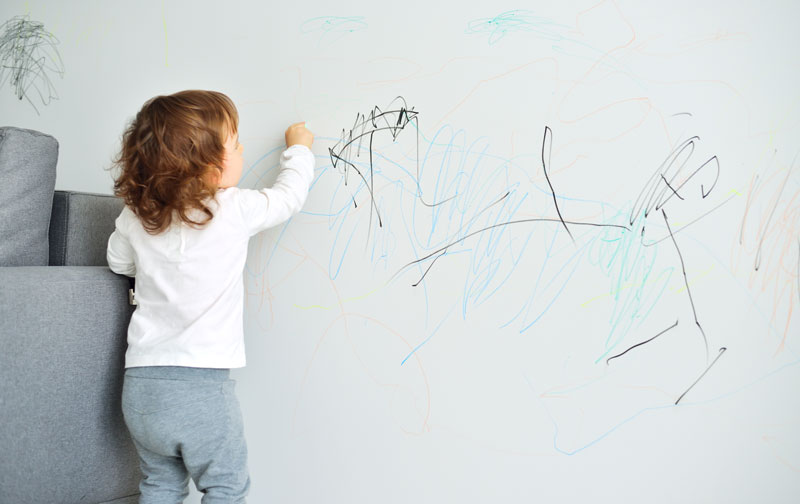Caring for Newly Painted Walls
After investing in your paint project, keep your walls looking clean and fresh for as long as possible, With a little care, it's easy to remove average household stains.
How to clean and protect against:
- Dirt, scuffs, and crayon
- Grease
- Pen and permanent marker
- Mildew
What You Should Know
Maintaining your newly painted surface can greatly increase its life and preserve its appearance, avoiding the need to repaint before it is necessary. To ensure maximum durability, wait at least two weeks after painting before cleaning any coating. As coatings cure, they become more durable and less likely to scratch and mar. It is recommended to test cleaning materials in an inconspicuous area to avoid damaging the coating or its color. When washing a surface, only do the minimum amount of cleaning necessary to avoid eroding the paint or creating any shiny spots. When washing an entire wall or area, always washing at the bottom and work your way up the wall. When rinsing reverse this procedure and rinse from the top of the wall down. This will stop the cleaner from causing streaks.
Flat, Eggshell and Satin Finishes
Duller paint finishes are more likely to burnish or mar when it comes to cleaning. Do not use harsh chemicals or degreasers when cleaning flat paint walls and be mindful when using a sponge not to scrub too hard. The sponge should be wrung out almost completely before putting it to the walls.
Semi-Gloss and Gloss Finishes
These paints are highly durable, so they're most commonly used in high-traffic areas like the kitchen and bathroom. Even though these paints are durable, higher sheen paints can burnish, so always use a soft sponge when cleaning walls.

Dirt, Scuffs, and Crayon
You may be able to adequately wash a wall using plain warm water. If the wall has stains or marks use a mixture of water and a small amount of mild, non-sudsing detergent. Avoid colored soaps or dyed sponges which can cause stains.
First, gently dab a stain with a damp rag or nonabrasive sponge, as it may come off without the need of soap or a cleaner. If that does not work, a stronger chemical cleaner may be needed, but only after testing. On completion, wipe the area with a damp cloth or sponge to remove any cleaner residue.
For more severe stains: Clean the surface with a nonabrasive cleaner like Simple Green® All-Purpose Cleaner or similar products using a sponge or soft cloth. Rinse all washed surfaces thoroughly with clean water. Any residue left can interfere with adhesion of paint applied later.
If the wall has stubborn stains or marks that can't be removed by cleaning, you may need to touch this area up.
Grease
If grease is present, clean area with a mild grease-cutting cleaner like dish soap. Be sure to test an area first and rinse walls well with water once applied. If heavier cleaning is needed, use cleaners such as Simple Green® or similar cleaners as these are mild and nonabrasive and excellent options for cleaning walls.
Pen and Permanent Marker
These marks are difficult to completely remove. To lessen the severity try using one of the following: Mr. Clean Magic Eraser® or Goof Off®. Be sure to follow instructions as well as strong solvent warnings. Be advised: Using any of these solutions will likely result in some damage to the paint coating.
Mildew
Mildew should be treated and never painted over. Apply a 3:1 mixture of water and household bleach to the area using a rag or sponge. Be sure to wear eye protection and gloves. Test a small area first to be sure the bleach solution will not cause fading. Allow mixture to remain on for 20 minutes; add more as it dries. Rinse the area thoroughly.



